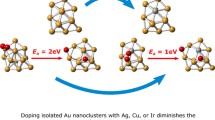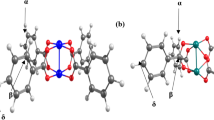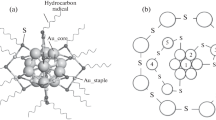Abstract
Incorporation of noble metal into metal–organic frameworks (MOFs) provides an opportunity to fine tune the structure and electronic properties of MOFs materials for many applications. Periodic density functional theory has been used to understand the nature of gold nanoparticle Aun cluster (n = 2, 4, 6, 8, 10, 12 and 14) inside zirconium-based MOFs (MOF-801). The Aun clusters were located inside the octahedral and tetrahedral pore of MOF-801 inducing confinement effect toward the structure of Aun cluster. Various parameters were calculated including the adsorption energy, deformation energy, density of states and intermolecular interaction between Aun cluster and MOF-801 surfaces. The studies indicate that the adsorption of Aun cluster is overall exothermic, and the Aun cluster inside the tetrahedral cage provides a higher stabilization energy. However, the presence of Aun cluster also induces deformation energy toward the MOF-801 structure. The binding sites of Aun cluster on the surface of MOF-801 has been assessed using the independent gradient model to unveil possible intermolecular forces between the host and guest system. The electronic bandgap has been assessed showing the possibility to modulate the bandgap energy by increasing the size of Aun cluster.






Similar content being viewed by others
References
Safaei M, Foroughi MM, Ebrahimpoor N, Jahani S, Omidi A, Khatami M (2019) A review on metal-organic frameworks: synthesis and applications, TrAC. Trends Anal Chem 118:401–425. https://doi.org/10.1016/j.trac.2019.06.007
Stock N, Biswas S (2012) Synthesis of metal-organic frameworks (MOFs): routes to various MOF topologies, morphologies, and composites. Chem Rev 112:933–969. https://doi.org/10.1021/CR200304E/ASSET/IMAGES/MEDIUM/CR-2011-00304E_0009.GIF
Yusuf VF, Malek NI, Kailasa SK (2022) Review on metal-organic framework classification, synthetic approaches, and influencing factors: applications in energy, drug delivery, and wastewater treatmentS, ACS. Omega 7:44507–44531. https://doi.org/10.1021/ACSOMEGA.2C05310/ASSET/IMAGES/LARGE/AO2C05310_0012.JPEG
Mandal S, Natarajan S, Mani P, Pankajakshan A (2021) Post-synthetic modification of metal-organic frameworks toward applications. Adv Funct Mater 31:2006291. https://doi.org/10.1002/ADFM.202006291
Evans JD, Sumby CJ, Doonan CJ (2014) Post-synthetic metalation of metal–organic frameworks. Chem Soc Rev 43:5933–5951. https://doi.org/10.1039/C4CS00076E
Li JR, Sculley J, Zhou HC (2012) Metal-organic frameworks for separations. Chem Rev 112:869–932. https://doi.org/10.1021/cr200190s
Kulak H, Polat HM, Kavak S, Keskin S, Uzun A (2019) Improving CO2 separation performance of MIL-53(Al) by incorporating 1-n-Butyl-3-Methylimidazolium Methyl Sulfate. Energy Technol 7:1900157. https://doi.org/10.1002/ENTE.201900157
Dou L, Wu S, Chen DL, He S, Wang FF, Zhu W (2018) Structures and electronic properties of Au clusters encapsulated ZIF-8 and ZIF-90. J Phys Chem C 122:8901–8909. https://doi.org/10.1021/ACS.JPCC.7B12480/ASSET/IMAGES/LARGE/JP-2017-12480Z_0009.JPEG
Chen DL, Wu S, Yang P, He S, Dou L, Wang FF (2017) Ab initio molecular dynamic simulations on Pd clusters confined in UiO-66-NH2. J Phys Chem C 121:8857–8863. https://doi.org/10.1021/ACS.JPCC.7B00957/ASSET/IMAGES/LARGE/JP-2017-009575_0007.JPEG
Vilhelmsen LB, Sholl DS (2012) Thermodynamics of pore filling metal clusters in metal organic frameworks: Pd in UiO-66. J Phys Chem Lett 3:3702–3706. https://doi.org/10.1021/JZ301806B/SUPPL_FILE/JZ301806B_SI_001.PDF
Wang FF, Liang F, Zhang Y, Chen X, Chen DL, Zhu W (2020) Stabilities and electronic structures of transition metal (Cu, Ag, Au, Ni, Pd, Pt) cluster-confined UiO-66. J Phys Chem C 124:28123–28131. https://doi.org/10.1021/ACS.JPCC.0C08997/ASSET/IMAGES/LARGE/JP0C08997_0010.JPEG
Pambudi FI, Pratiwi NS, Chusnawati U (2023) First-principle study on the lattice-directed missing linker defect in zirconium based metal-organic framework (MOF-801): electronic properties and interaction with hydrogen. Mater Today Commun 35:105967–105998. https://doi.org/10.1016/j.mtcomm.2023.105967
Dhakshinamoorthy A, Asiri AM, Garcia H (2017) Metal organic frameworks as versatile hosts of Au nanoparticles in heterogeneous catalysis. ACS Catal 7:2896–2919. https://doi.org/10.1021/ACSCATAL.6B03386/ASSET/IMAGES/MEDIUM/CS-2016-033866_0031.GIF
Sun D, Liu W, Fu Y, Fang Z, Sun F, Fu X, Zhang Y, Li Z (2014) Noble metals can have different effects on photocatalysis over metal-organic frameworks (MOFs): a case study on M/NH 2 -MIL-125(Ti) (M=Pt and Au). Chem - A Eur J 20:4780–4788. https://doi.org/10.1002/chem.201304067
Wang ZJ, Li Q, Tan LL, Liu CG, Shang L (2022) (2022) Metal-organic frameworks-mediated assembly of gold nanoclusters for sensing applications. J. Anal. Test. 62(6):163–177. https://doi.org/10.1007/S41664-022-00224-0
Sun Z, Wu S, Ma J, Shi H, Wang L, Sheng A, Yin T, Sun L, Li G (2019) Colorimetric sensor array for human semen identification designed by coupling zirconium metal-organic frameworks with DNA-modified gold nanoparticles. ACS Appl Mater Interfaces 11:36316–36323. https://doi.org/10.1021/acsami.9b10729
Cao F, Ju E, Liu C, Li W, Zhang Y, Dong K, Liu Z, Ren J, Qu X (2017) Encapsulation of aggregated gold nanoclusters in a metal–organic framework for real-time monitoring of drug release. Nanoscale 9:4128–4134. https://doi.org/10.1039/C7NR00073A
Ding X, Li Z, Yang J, Hou JG, Zhu Q (2004) Adsorption energies of molecular oxygen on Au clusters. J Chem Phys 120:9594–9600. https://doi.org/10.1063/1.1665323
Pyykkö P (2004) Theoretical chemistry of gold. Angew Chemie Int Ed 43:4412–4456. https://doi.org/10.1002/anie.200300624
Butova VV, Kirichkov MV, Budnyk AP, Guda AA, Soldatov MA, Lamberti C, Soldatov AV (2018) A room-temperature growth of gold nanoparticles on MOF-199 and its transformation into the [Cu2(OH)(BTC)(H2O)]n phase. Polyhedron 154:357–363. https://doi.org/10.1016/J.POLY.2018.08.002
Zhang Y, Hu Y, Li G, Zhang R (2019) A composite prepared from gold nanoparticles and a metal organic framework (type MOF-74) for determination of 4-nitrothiophenol by surface-enhanced Raman spectroscopy. Microchim Acta 186:1–10. https://doi.org/10.1007/S00604-019-3618-Z/FIGURES/6
Gordillo MA, Benavides PA, Ma K, Saha S (2022) Transforming an insulating metal-organic framework (MOF) into semiconducting MOF/gold nanoparticle (AuNP) and MOF/Polymer/AuNP composites to gain electrical conductivity. ACS Appl Nano Mater 5:13912–13920. https://doi.org/10.1021/ACSANM.2C03643/ASSET/IMAGES/LARGE/AN2C03643_0004.JPEG
Cure J, Mattson E, Cocq K, Assi H, Jensen S, Tan K, Catalano M, Yuan S, Wang H, Feng L, Zhang P, Kwon S, Veyan JF, Cabrera Y, Zhang G, Li J, Kim M, Zhou HC, Chabal YJ, Thonhauser T (2019) High stability of ultra-small and isolated gold nanoparticles in metal–organic framework materials. J Mater Chem A 7:17536–17546. https://doi.org/10.1039/C8TA12334A
Vilhelmsen LB, Walton KS, Sholl DS (2012) Structure and mobility of metal clusters in MOFs: Au, Pd, and AuPd clusters in MOF-74. J Am Chem Soc 134:12807–12816. https://doi.org/10.1021/JA305004A/SUPPL_FILE/JA305004A_SI_001.PDF
Wang C, Xiong C, Zhang X, He Y, Xu J, Zhao Y, Wang S, Zheng J (2022) External optimization of Zr-MOF with mercaptosuccinic acid for efficient recovery of gold from solution: adsorption performance and DFT calculation. Sep Purif Technol 296:121329. https://doi.org/10.1016/J.SEPPUR.2022.121329
Lin S, Kumar Reddy DH, Bediako JK, Song MH, Wei W, Kim JA, Yun YS (2017) Effective adsorption of Pd(II), Pt(IV) and Au(III) by Zr(IV)-based metal–organic frameworks from strongly acidic solutions. J. Mater. Chem. A. 5:13557–13564. https://doi.org/10.1039/C7TA02518A
Cavka JH, Jakobsen S, Olsbye U, Guillou N, Lamberti C, Bordiga S, Lillerud KP (2008) A new zirconium inorganic building brick forming metal organic frameworks with exceptional stability. J Am Chem Soc 130:13850–13851. https://doi.org/10.1021/ja8057953
Furukawa H, Gándara FG, Zhang Y-B, Jiang J, Queen WL, Hudson MR, Yaghi OM (2014) Water adsorption in porous metal−organic frameworks and related materials. J Am Chem Soc 136:4381. https://doi.org/10.1021/ja500330a
Kühne TD, Iannuzzi M, Del Ben M, Rybkin VV, Seewald P, Stein F, Laino T, Khaliullin RZ, Schütt O, Schiffmann F, Golze D, Wilhelm J, Chulkov S, Bani-Hashemian MH, Weber V, Borštnik U, Taillefumier M, Jakobovits AS, Lazzaro A, Pabst H, Müller T, Schade R, Guidon M, Andermatt S, Holmberg N, Schenter GK, Hehn A, Bussy A, Belleflamme F, Tabacchi G, Glöß A, Lass M, Bethune I, Mundy CJ, Plessl C, Watkins M, VandeVondele J, Krack M, Hutter J (2020) CP2K: an electronic structure and molecular dynamics software package - quickstep: efficient and accurate electronic structure calculations. J Chem Phys 152:194103–194198. https://doi.org/10.1063/5.0007045
Perdew JP, Burke K, Ernzerhof M (1996) Generalized gradient approximation made simple. Phys Rev Lett 77:3865–3868. https://doi.org/10.1103/PhysRevLett.77.3865
Pambudi FI, N. (2021) Prasetyo, insight into the structure of the heulandite-type zeolite containing aromatic compounds using periodic density functional theory. Mater. Today Commun. 26:102028–102098. https://doi.org/10.1016/j.mtcomm.2021.102028
Golze D, Iannuzzi M, Hutter J (2017) Local fitting of the Kohn-Sham density in a gaussian and plane waves scheme for large-scale density functional theory simulations. J Chem Theory Comput 13:2202–2214. https://doi.org/10.1021/acs.jctc.7b00148
Wang X-D, Huang Y-H, Liao J-F, Jiang Y, Zhou L, Zhang X-Y, Chen H-Y, Kuang D-B (2019) In situ construction of a Cs 2 SnI 6 perovskite nanocrystal/SnS 2 nanosheet heterojunction with boosted interfacial charge transfer. J Am Chem Soc 141:13434–13441. https://doi.org/10.1021/jacs.9b04482
Bao Q, Zhang W, Mei D (2021) Theoretical characterization of zeolite encapsulated platinum clusters in the presence of water molecules. Phys Chem Chem Phys 23:23360–23371. https://doi.org/10.1039/D1CP03766H
Heyd J, Scuseria GE (2004) Efficient hybrid density functional calculations in solids: assessment of the Heyd–Scuseria–Ernzerhof screened Coulomb hybrid functional. J Chem Phys 121:1187–1192. https://doi.org/10.1063/1.1760074
Lu T, Chen F (2012) Multiwfn: a multifunctional wavefunction analyzer. J Comput Chem 33:580–592. https://doi.org/10.1002/jcc.22885
Lefebvre C, Khartabil H, Boisson JC, Contreras-García J, Piquemal JP, Hénon E (2018) The independent gradient model: a new approach for probing strong and weak interactions in molecules from wave function calculations. ChemPhysChem 19:724–735. https://doi.org/10.1002/cphc.201701325
Häkkinen H (2008) Atomic and electronic structure of gold clusters: understanding flakes, cages and superatoms from simple concepts. Chem Soc Rev 37:1847. https://doi.org/10.1039/b717686b
Bakhtian M, Khosroshahi N, Safarifard V (2022) Efficient removal of inorganic and organic pollutants over a NiCo2O4@MOF-801@MIL88A photocatalyst: the significance of ternary heterojunction engineering. ACS Omega. https://doi.org/10.1021/acsomega.2c05000
Acknowledgements
The authors gratefully thanks to the support from the Department of Chemistry, Faculty of Mathematics and Natural Sciences, Universitas Gadjah Mada .
Funding
Funding was provided by Department of Chemistry, Universitas Gadjah Mada
Author information
Authors and Affiliations
Contributions
FIP contributed to conceptualization, methodology, formal analysis, investigation, writing—original draft, and supervision. MRN contributed to formal analysis, investigation, writing—review & editing.
Corresponding author
Ethics declarations
Conflict of interest
The authors declare that they have no known competing financial interests or personal relationship that could have appeared to influence the work reported in this paper.
Additional information
Publisher’s Note
Springer Nature remains neutral with regard to jurisdictional claims in published maps and institutional affiliations.
Supplementary Information
Below is the link to the electronic supplementary material.
Rights and permissions
Springer Nature or its licensor (e.g. a society or other partner) holds exclusive rights to this article under a publishing agreement with the author(s) or other rightsholder(s); author self-archiving of the accepted manuscript version of this article is solely governed by the terms of such publishing agreement and applicable law.
About this article
Cite this article
Pambudi, F.I., Najib, M.R. Structure and electronic properties of Aun cluster (n = 2,4,6,8,10,12,14) in zirconium-based metal–organic framework (MOF-801): density functional theory studies. Theor Chem Acc 142, 82 (2023). https://doi.org/10.1007/s00214-023-03030-8
Received:
Accepted:
Published:
DOI: https://doi.org/10.1007/s00214-023-03030-8




